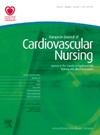Incidence and assessment of delirium following open cardiac surgery; A systematic review and meta-analysis
IF 2.9
3区 医学
Q2 CARDIAC & CARDIOVASCULAR SYSTEMS
引用次数: 0
Abstract
Aim This systematic review and meta-analysis sought i) to provide an overview of the incidence of delirium following open cardiac surgery and ii) to investigate how incidences of delirium are associated with different assessment tools. Methods and results A systematic search of studies investigating delirium following open cardiac surgery were conducted in Medline (Ovid), EMBASE, PsycINFO, CiNAHL and the Cochrane Database. Only studies with patients diagnosed or screened with a validated tool were included. Studies published from 2005 to 2021 were included in the meta-analysis. Of 7,126 individual studies retrieved, 106 met the inclusion criteria for the meta-analysis, hereof 31% of high quality. The weighted pooled incidence of delirium following open cardiac surgery across all studies was 23% (95% CI 20-26%), however we found a considerable heterogeneity (I2 = 99%), which could not be explained by subgroups or further sensitivity analyses. The most commonly applied screening tool for delirium is CAM/CAM-ICU. The lowest estimates of delirium were found by applying the Delirium Observation Scale (incidence 14%, 95% CI 8-20%), and the highest estimates in studies using “other” screening tools (Organic Brain Symptom Scale, Delirium Symptom Interview) pooled incidence of 43%, (95% CI 19 - 66%), however, only two studies applied these. Conclusion Delirium following open cardiac surgery remains a complication with a high incidence of overall 23%, when applying a validated tool for screening or diagnosis. Nevertheless, this systematic review and meta-analyses highlight the significant inconsistency in current evidence regarding assessment tools and regimens. Registration Prospero CRD42020215519开胸心脏手术后谵妄的发生率和评估;系统回顾和荟萃分析
目的 本系统综述和荟萃分析旨在 i) 概述开胸心脏手术后谵妄的发生率;ii) 研究谵妄的发生率与不同评估工具之间的关系。方法与结果 在 Medline (Ovid)、EMBASE、PsycINFO、CiNAHL 和 Cochrane 数据库中对开胸手术后谵妄的研究进行了系统检索。仅纳入使用有效工具诊断或筛查患者的研究。荟萃分析纳入的研究发表于 2005 年至 2021 年。在检索到的 7126 项研究中,106 项符合荟萃分析的纳入标准,其中 31% 为高质量研究。在所有研究中,开胸心脏手术后谵妄的加权汇总发生率为23%(95% CI 20-26%),但我们发现存在相当大的异质性(I2 = 99%),这无法通过亚组或进一步的敏感性分析来解释。最常用的谵妄筛查工具是CAM/CAM-ICU。使用谵妄观察量表对谵妄的估计值最低(发生率为14%,95% CI为8-20%),使用 "其他 "筛查工具(脑器质性症状量表、谵妄症状访谈)的研究对谵妄的估计值最高,汇总发生率为43%(95% CI为19-66%),但只有两项研究使用了这些工具。结论 开胸心脏手术后谵妄仍是一种并发症,在应用有效工具进行筛查或诊断时,其发生率较高,总体为 23%。尽管如此,本系统综述和荟萃分析强调了目前有关评估工具和方案的证据存在严重的不一致性。注册 Prospero CRD42020215519
本文章由计算机程序翻译,如有差异,请以英文原文为准。
求助全文
约1分钟内获得全文
求助全文
来源期刊

European Journal of Cardiovascular Nursing
CARDIAC & CARDIOVASCULAR SYSTEMS-NURSING
CiteScore
5.10
自引率
10.30%
发文量
247
审稿时长
6-12 weeks
期刊介绍:
The peer-reviewed journal of the European Society of Cardiology’s Council on Cardiovascular Nursing and Allied Professions (CCNAP) covering the broad field of cardiovascular nursing including chronic and acute care, cardiac rehabilitation, primary and secondary prevention, heart failure, acute coronary syndromes, interventional cardiology, cardiac care, and vascular nursing.
 求助内容:
求助内容: 应助结果提醒方式:
应助结果提醒方式:


